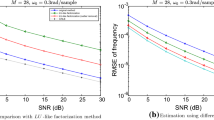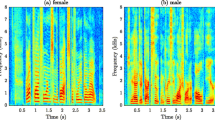Abstract
Algorithms like MUSIC are widely used for harmonic analysis of signal when there are limited numbers of data samples and harmonics are closely spaced. These algorithm works based on decomposing autocorrelation matrix of analyzed signal into signal space and noise space, but performance degraded if selected signal space and noise space are not chosen correctly. Our main contribution to this paper is the estimation of signal space and noise space for unknown signals so that subspace harmonic analysis technique can be applied to unknown signal too. Estimation of signal space is based on eigenvalue distribution of correlation matrix of analyzed signal. A threshold is calculated to differentiate between signal space and noise space. Performance of technique is shown through simulation.
Access this chapter
Tax calculation will be finalised at checkout
Purchases are for personal use only
Similar content being viewed by others
References
Candan, C.: A method for fine resolution frequency estimation from three DFT samples. IEEE Signal Process. Lett., 18, 351–354 (2011).
Pisarenko, V. F.: The retrieval of harmonics from a covariance function. Geophysics. J. Roy. Atron. Soc., 33, 347–366 (1973).
Stoica, P.; Söderström, T. S.: Statistical analysis of MUSIC and subspace rotation estimates of sinusoidal frequencies. IEEE Trans. Signal Process, 39, 1836–1847 (1991).
Roy, R.; Paulraj, P.; Kailath, T.: ESPRIT–a subspace rotation approach to estimation of parameters of cisoids in noise. IEEE Trans. Acoust., Speech, Signal Process., 34, 1340–1342 (1986).
Li, F.; Vaccaro, R. J.; Tufts, D. W.: Performance analysis of the statespace realization (TAM) and ESPRIT algorithms for DOA estimation. IEEE Trans. Antennas Propag., 39, 418–423 (1991).
Vlok, J. D.; Olivier, J.C.: Analytic approximation to the largest Eigenvalue distribution of a white Wishart matrix. IET Communications, 6, 1804–1811 (2012).
Kay, S. M.: Extensions for complex data and parameters. Fundamentals of Statistical Signal Processing: Estimation Theory, Prentice-Hall, (1993).
Author information
Authors and Affiliations
Corresponding author
Editor information
Editors and Affiliations
Rights and permissions
Copyright information
© 2018 Springer Nature Singapore Pte Ltd.
About this paper
Cite this paper
Kumar, R., Verma, P.K. (2018). Signal Space Estimation: Application to Subspace Spectrum Analysis. In: Perez, G., Tiwari, S., Trivedi, M., Mishra, K. (eds) Ambient Communications and Computer Systems. Advances in Intelligent Systems and Computing, vol 696. Springer, Singapore. https://doi.org/10.1007/978-981-10-7386-1_14
Download citation
DOI: https://doi.org/10.1007/978-981-10-7386-1_14
Published:
Publisher Name: Springer, Singapore
Print ISBN: 978-981-10-7385-4
Online ISBN: 978-981-10-7386-1
eBook Packages: EngineeringEngineering (R0)




